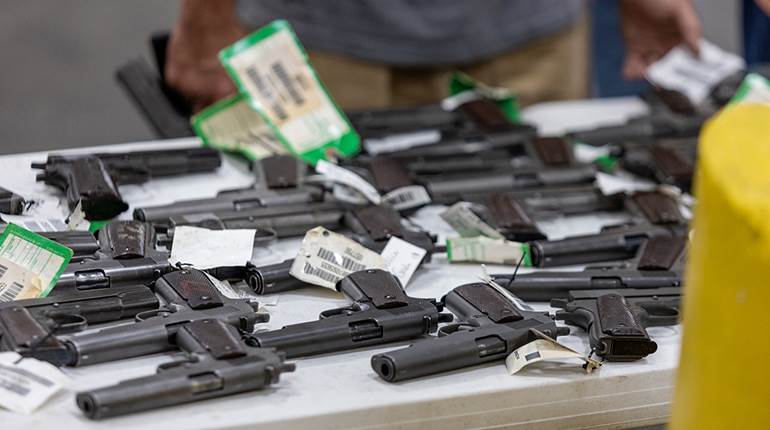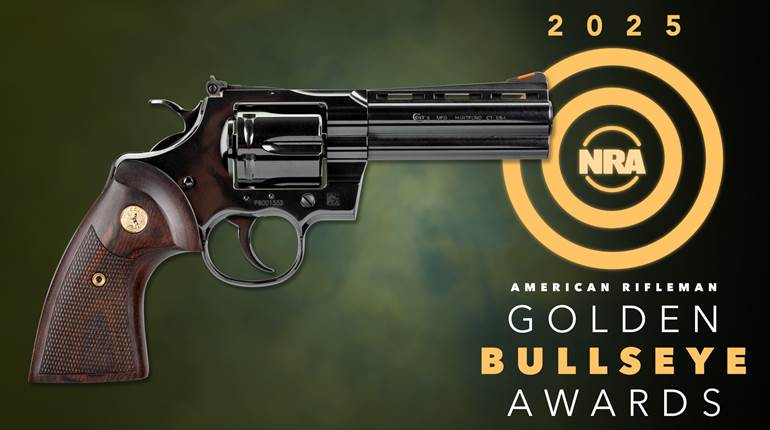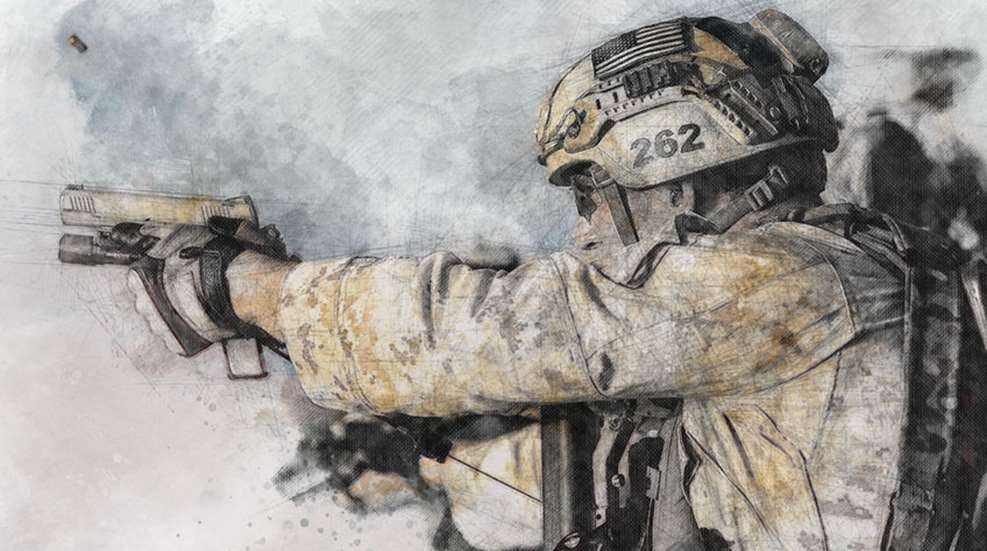
It was the kind of day that a gun guy can never forget. Stack upon stack of crisp-cornered cardboard boxes weighed down a work bench in the armory of what is now called the Marine Raider Training Center. The instructors had been eagerly awaiting the arrival of the pistols, the first new military-issue Colt M1911s since 1945. The Marine Corps had chosen the tan Colts, official designation M45A1, as a commercial replacement for the legendary, custom, Quantico-built M1911s issued to U.S. Marine Corps Forces Special Operations Command (MARSOC) Marine Raiders and the Corps’ Force Reconnaissance Marines. I was looking at the first shipment from that contract, and my Marines would be the first to be issued the .45s.
I went through the boxes with the armorers, examining a few random Colts to get a sense of the pistols. The .45s had a number of features that jumped right out: the light rails, the aggressively checkered G10 stocks—which replaced the Pachmayrs we had used for so long—tritium vials in the Novak sights, and unique markings on the frames and slides. Cycling the pistols revealed the fit to be smooth but clearly tighter than a typical commercial M1911. The triggers were uniformly pretty good. These were going right to work, and they looked promising.
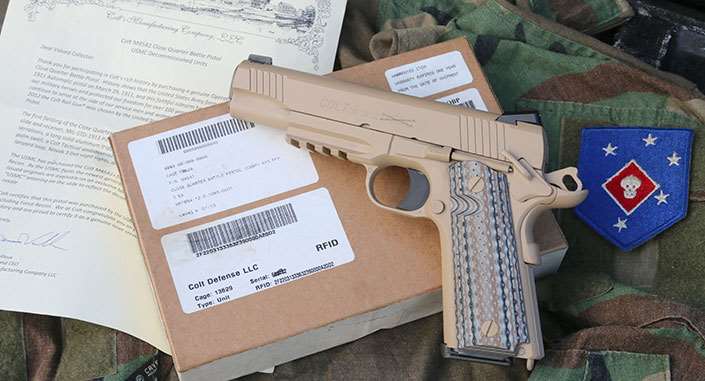
Interestingly, many of these very same pistols recently hit the civilian market in a way that took military enthusiasts and collectors completely by surprise. A large batch, rumored to be nearly 1,000 pistols, hit the Gunbroker auction site (gunbroker.com) described as decommissioned USMC 1911 M45A1s. It was largely (maybe entirely) unannounced and seemed odd, or even suspect, but there was a factory letter from Colt to guarantee authenticity. The pistols shipped in the original cardboard container with the contract-correct black Wilson Combat seven-round magazine. Before word could even circulate in casual conversation, the pistols were snapped up at prices that were lower than comparable commercial Colts. I was at my local gun shop when a Marine was picking up two that he had won. They were certainly the genuine article, with the exception that Colt had marked through the large “USMC” on the slide with a laser-etched “X” to signify the decommissioning.
A large number of certified modern U.S. military handguns on the market is mostly unheard of. Even more so considering these guns were largely expected to be the last government-issue M1911s and, further, models specific to Marine Raiders and Force Reconnaissance. Collectors and shooters reacted predictably, and the Colts began to flip over on Gunbroker at two-week intervals, each time gaining several hundred dollars in asking price. The prices seemed to stabilize in the mid-$3,000s, and then the pistols largely stopped moving, presumably occupying prized places in safes across the country. In recent months, the auction houses have listed a few with the prices for the pristine unissued handguns estimated around $7,000.
How did the pistols get to market? You will hear different stories, but the simplest is that the M45A1 was Colt’s first large-scale run of Cerakoted pistols. The earliest production samples had isolated instances where the application of the tan coating was suspected by the end users to be causing reliability issues. In other cases on specific guns, the finish was not wearing as durably as expected. My opinion is that both of these were likely due to Colt learning the quirks of a new coating process.
Nonetheless, the Marines had been eagerly waiting for the new .45s, and they were going directly into operational use, so there was little patience for a learning curve, and many of the Marines demanded a change. Quantico began exhaustive testing on other finishes to specify a modification to the contract. When the change was specified, a substantial number of the early pistols were recalled back to Colt, and it disposed of them, leading to the market frenzy.
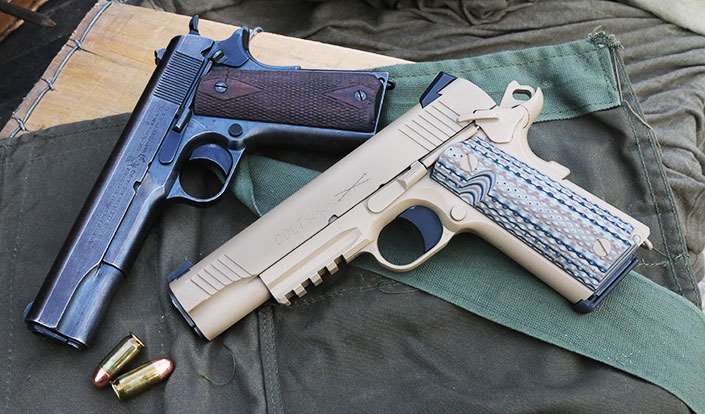
I was able to lay my hands on one of the decommissioned M45A1s to examine and evaluate it. The Colt appeared to be unissued and had probably not been fired since leaving the factory. Many of the issued pistols that came to market have the “tells” of service life: paint pen or spray paint stenciled rack numbers, holster wear, dings or gouges from rough use. This one likely sat in the armory or in a warehouse waiting its turn in the arena.
The one-of-a-kind markings are all there. There is the “EGA” serial suffix (for the Corps’ iconic eagle, globe and anchor insignia), the “U.S.” markings, and the small set of numbers and “CQBP” denoting the official description of “Close Quarters Battle Pistol.” The inboard side of the handgun has a rather large “COLT***USMC” marking that struck me at the time of issue as gaudy and a blatant attempt by Colt to mark the government-contract pistols in such a way as to facilitate marketing the look-alike commercial version. If one looks closely at the trigger guard, Colt has the V-shaped proofmark that was present on earlier government handguns, such as the 1909 USMC revolver.
The solid, medium-long trigger broke at 4 lbs., 4 ozs., of pressure after a short bit of take-up to release the hammer. There is slight movement and a feel of “roll” through the break, but I wouldn’t necessarily call it creep in a negative sense. The trigger was eminently usable and a good match for a combat pistol intended for highly trained special operations forces. The action incorporates the Series 80 mechanism that blocks the firing pin until the trigger is pulled.
I can clearly recall the day that I met up with our Close Quarters Battle instructors to try out the new M45A1s for the first time. I don’t know that any pistols, the old Quantico M45s or the new Colts, were ever truly benched or grouped. Most of the time standing slow fire at 25 yds. in the shooter’s hands was the measure of the pistol’s accuracy. However, the group all remarked that the pistols certainly seemed to be accurate using the government-issue hardball ammunition.
This sample proved that sentiment. I fired representative groups from a rest with several loads rather than the full five-group protocol typically used in product reviews in order to minimize the rounds and wear on the Colt. Each knotted tight groups that would do a custom pistol proud, averaging 1.48" for five separate loads.
Representative five-shot group (25 yds.)
• Black Hills 200-gr. SWC 1.49"
• Hornady 200-gr. XTP 1.47"
• Nosler 185-gr. JHP handload 1.20"
• Wilson Combat 200-gr. Match 1.60"
• Winchester 230-gr. FMJ 1.65"
That level of accuracy is truly noteworthy in a randomly selected, government-issue pistol. The firearm felt like it had close tolerances, with everything locking up firmly, but without that hand-fitted exactness one can feel in a custom M1911. This particular sample disproved decades’ worth of gun magazine lore about a combat-grade .45 needing to be loose for reliability and thus incompatible with custom-level accuracy. The Colt gobbled up a wide variety of bullet profiles, cycling smoothly and without hesitation, while grouping each in a cluster that fit within the space the front sight covered at any given distance.
In the hand, that level of precision translated to straightforward hits on tough and distant targets. Hitting an 8" plate at 50 yds. was not the question, rather, it was how tightly I could group the splatter marks. At 40 yds. I was able to put five of eight shots onto my 3"-wide “truth teller” steel target—a task that is normally a tough slog at 25 yds. for most service pistols. This particular sample earned every bit of the “National Match” stamping on the barrel hood.
The Colt incorporates the dual recoil spring assembly of the firm’s recent commercial models, which seemed to dampen recoil somewhat. More importantly, this feature was intended to decrease the battering the pistol takes on recoil. This is important in a gun meant to endure nearly as many rounds in the weeks-long Marine Raider training regimen as the original M1911 was intended to see throughout its entire service life. The coarse checkering on the multi-colored G10 panels does assist in anchoring the handgun, and the Marine pistol has an undercut trigger guard to allow a high hand hold. Each time I handle the M45A1, though, I silently bemoan Colt’s decision to leave the frontstrap untextured, particularly in a .45 that is often fired while wearing gloves.
The Colt incorporates a slightly beveled magazine well to facilitate reloads. The pistol wears bilateral thumb safeties, which have somewhat oversize, though low-profile, ledges designed to be easily disengaged while not interfering with the non-firing hand’s grasp. The .45 maintains a traditional military lanyard loop in the flat, serrated mainspring housing. Beyond the tan color, forward slide serrations and the section of M1913 Picatinny accessory rail immediately standout and separate the pistol from the typical service M1911.
In a corridor of the Pentagon there is a larger-than-life mural showing a circa-1915 Maj. Smedley Butler leading his men in the recapture of Fort Rivieré during the Banana Wars—the newly issued M1911 in hand as he and his Marines engaged the Caco rebels in hand-to-hand combat. While Maj. Butler might be taken aback by the tritium capsules in the M45A1’s sights or perhaps a mounted SureFire light, it is likely that he could operate and fieldstrip the new USMC Colt with no difficulty. That is quite a service legacy for any military firearm.
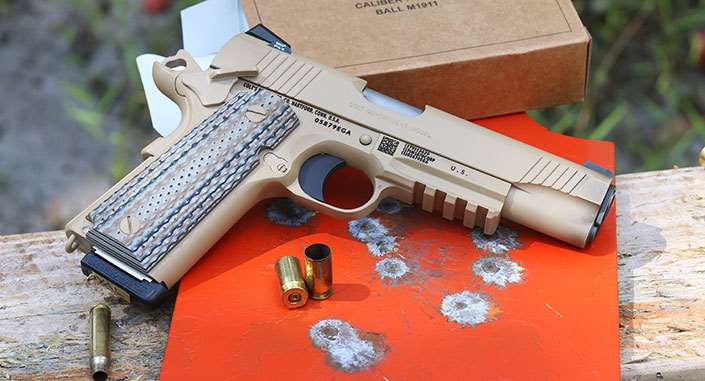
I recently came across a passage from Jeff Cooper written in 1961 that read, “the big pistol [1911] has been with us for half a century, and as yet no better sidearm—for serious combat work—has been devised.” It is a testament to the enduring nature of the M1911 that a full 50 years later the Corps was issuing the latest version of the design in the M45A1. I didn’t think much on it at the time, but as we received those first tan Colts and issued them out to our Raiders it was just a few months more than 100 years since Colt had delivered its initial shipment of the “U.S. Pistol, Model of 1911” to the Marine Corps.
The M45A1 serves still today, but it will almost certainly be the final chapter in the U.S. military service life of the M1911. My old unit carried them on special operations missions around the world for a couple of years and then completed the en masse switch to the Glock 19 that had been occurring gradually even before the Colt’s adoption. The M45 serves on with a few specialized Marine Corps units and is expected to for a few more years when most think it will be replaced by a polymer-frame, striker-fired 9 mm, thus ending a long and historic run for the M1911 and its .45 ACP cartridge.
These decommissioned Colts will continue to be a hot item among both shooters and collectors for the foreseeable future. The pistols are exceptional purely as shooters, and scarce and significant for several military and historic reasons. We are fortunate that they found their way onto the public market.












